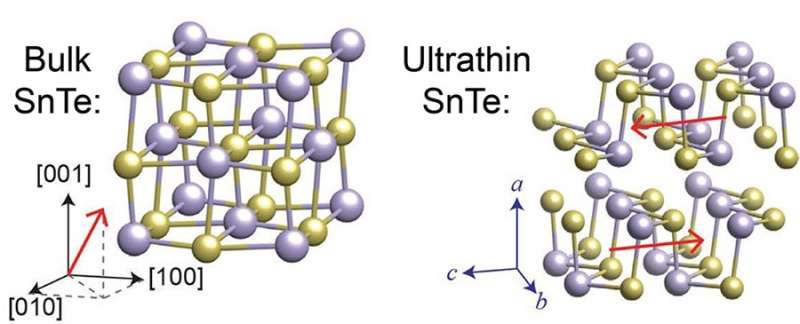Research uncovers the spontaneous polarization of novel ultrathin materials

Many materials exhibit new properties when in the form of thin films composed of just a few atomic layers. Most people are familiar with graphene, the two-dimensional form of graphite, but thin film versions of other materials also have the potential to facilitate technological breakthroughs.
For example, a class of three-dimensional materials called Group-IV monochalcogenides are semiconductors that perform in applications such as thermoelectrics and optoelectronics among others. Researchers are now creating two-dimensional versions of these materials, in the hope that they will offer improved performance or even new applications.
Recently, a research team that includes Salvador Barraza-Lopez, associate professor of physics at the U of A and Taneshwor Kaloni, a former post-doctoral researcher in Barraza-Lopez's lab, has shed light on the behavior of one of these ultrathin materials known as tin telluride (SnTe). Barraza-Lopez and his colleagues at the Max-Planck Institute of Microstructure Physics in Germany, the Key Laboratory of Low-Dimensional Quantum Physics and the Collaborative Innovation Center of Quantum Matter in China and the RIKEN Center for Emergent Matter Science in Japan recently published a paper on their findings in the journal Advanced Materials.
The researchers used a variable temperature scanning tunneling microscope to study the structure and polarization of SnTe thin films grown on graphene substrates. They studied the material at a range of temperatures, from 4.7 Kelvin to over 400 Kelvin. They discovered that when SnTe is only a few atomic layers thick, it forms a layered structure that is different from the bulk, rhombic-shaped version of the material. The Arkansas team contributed to this research by providing calculations that account for the quantum mechanical nature of these atomic structures, using a method known as density functional theory.
The atoms in ultrathin SnTe create electric dipoles oriented along opposite directions in every other atomic layer, which makes the material anti-polar, as opposed to the bulk sample in which all layers point along the same direction. Moreover, the transition temperature, which is the temperature at which the material loses this spontaneous polarization, is much higher than that of the bulk material.
"[These findings] underline the potential of atomically thin g-SnTe films for the development of novel spontaneous polarization-based devices," said the researchers in the paper.
More information: Kai Chang et al. Enhanced Spontaneous Polarization in Ultrathin SnTe Films with Layered Antipolar Structure, Advanced Materials (2018). DOI: 10.1002/adma.201804428
Journal information: Advanced Materials
Provided by University of Arkansas





















